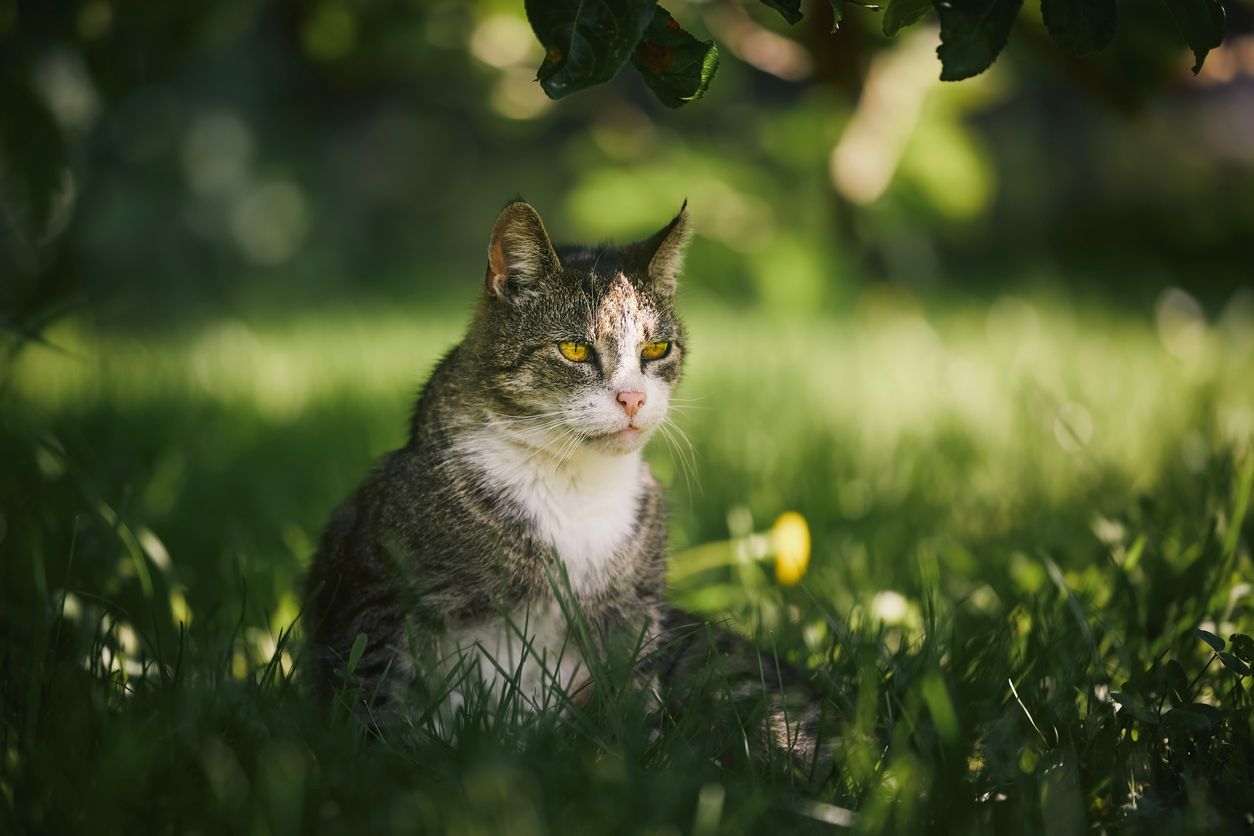What to do if your cat has arthritis and what you can do at home

Disclaimer: This article, its content, and its related references do not constitute veterinary advice and should not be considered a substitute for veterinary care. If your pet is showing any symptoms that could indicate a medical emergency, please seek immediate emergency care.
Osteoarthritis (OA) is the most common type of arthritis in cats and occurs when the cartilage and fluid between joints degrade over time, allowing the bones to rub against each other. This causes chronic pain, inflammation, and mobility problems. Though OA can’t be cured, there are ways for cat owners to manage the disease and improve their pet’s quality of life. Read on to learn:
- What osteoarthritis is and how it develops
- Ways to manage osteoarthritis in cats
- Signs of pain in cats caused by arthritis
- What to do if you think your cat has arthritis
Osteoarthritis can’t be cured and progresses over time. Veterinary guidance is necessary for an accurate diagnosis and for strategies that minimize symptoms and slow the disease’s progression. It’s important to be able to recognize subtle signs of pain in your cat so you can get prompt veterinary care. In general, the earlier OA is detected and treated in cats, the better the condition can be managed for a longer period of time.
What is arthritis in cats?
Arthritis describes the inflammation of a joint and has several causes, including:
- Bacterial, viral, or fungal infection
- Joint injury
- Immune-mediated disease
- Degenerative changes over time due to wear and tear on the joints
Osteoarthritis (OA) is the most common type of arthritis in cats and is commonly shortened to simply “arthritis.” It’s a degenerative joint disease in which the cartilage wears down over time, causing the bones of the joint to painfully rub together. OA leads to joint pain and inflammation, leading to mobility problems. Osteoarthritis is very common in cats, especially in seniors. Most senior cats have some degree of OA.
How do cats get osteoarthritis?
Osteoarthritis in cats occurs when the cushioning cartilage and fluid between the joints are worn away over time. Anything that increases the wear and tear on the joints hastens the development of arthritis, such as:
Eventually, the cartilage and joint fluid wear away enough that the bones rub against each other. The resulting inflammation leads to additional tissue destruction, chronic pain, and mobility issues.
Cat osteoarthritis management options
Feline osteoarthritis is a chronic, progressive disease that can’t be cured. There are some ways to manage symptoms of arthritis and help make day-to-day activities easier. “Successful management of feline osteoarthritis not only reduces symptoms but also may play a role in delaying its progression,” states Dr. Jo Myers. Veterinarians use a multimodal approach to managing OA in cats. Talk to a veterinarian to learn which strategies are best for your cat.
Weight management
Excess body weight puts extra strain on the joints, causing OA to progress faster and symptoms to worsen. Maintaining a healthy weight is one of the most important arthritis treatments for cats. Weight loss may be recommended for some cats with osteoarthritis to ease joint strain.
Medication and pain management
Anti-inflammatories and pain medications can help temporarily relieve arthritis pain in some cats. It’s crucial to only give medications that have been recommended or prescribed by a veterinarian and to give them as instructed. Cats are very sensitive to many of the medications used to manage arthritis in dogs and people. Some common human pain medications, such as acetaminophen (Tylenol) and ibuprofen (Advil), are highly toxic to cats. A veterinarian can offer safer alternatives for managing a cat’s arthritis pain.
Oral medications and injections can offer cats temporary relief from arthritis pain. Oral medications can be given at home, though they’re much easier to give to some cats than others. Injections are typically given at a vet’s office and may be a better option for cats who don’t tolerate oral medications. Talk to a veterinarian about medication options to best help your cat’s OA pain.
Environmental adaptation
Adapting a cat’s environment can help make daily life easier and less painful. Some cats may benefit from:
- Low-sided litter boxes with easy entries
- Elevated food and water dishes
- Ramps and steps to favorite elevated places
- Ample soft bedding and heated beds throughout the home
Jumping and climbing put a lot of stress on the joints, which can be painful for cats with OA. Limiting the amount of jumping a cat has to do by making sure food, water, and litter boxes are easy to get to can help make daily activities easier. Cat owners may need to discourage jumping by blocking access to some high places or provide pet ramps or stairs to make them easier to reach. Flat or slanted scratching mats may be easier than vertical posts for some cats. Also, providing soft, warm areas to rest may support the joints and provide pain relief.
Physical therapy and exercise
Daily physical activity and exercise are still important for most cats with osteoarthritis. Providing toys that promote movement without high-impact running or jumping helps maintain ideal body weight, encourages range of motion, and improves muscle tone. Play sessions may need to become shorter and more gentle than they were in the past to prevent more wear and tear on the joints.
Physical therapy can help relieve joint pain in cats and improve range of motion. Options for home therapy options include:
- Gentle massage
- Assisted stretching
- Heat therapy
Talk to a veterinarian or rehabilitation specialist about what may benefit your cat based on their symptoms and tolerance. Not all cats will tolerate all forms of exercise or physical therapy. A veterinarian may also be able to provide alternative therapies in the office.
Joint supplements
There are many nutritional supplements on the market targeted for feline osteoarthritis. However, there’s limited evidence to support the effectiveness of joint supplements for OA, and more studies are needed to determine which supplements may be beneficial and what the necessary doses are. Manufacturers aren’t required to publish data showing their supplements are safe and effective, or even that they contain the advertised ingredients. It doesn’t hurt to try a supplement if it’s recommended by a veterinarian, but it’s best to limit supplements to those that are vet-recommended.
Common signs of arthritis in cats
OA symptoms can vary between cats, and not all cats have every symptom or even obvious signs. The severity of symptoms also varies between cats. Cats mask pain very well and may not have obvious signs of pain. A cat with OA can still have severe pain even if their symptoms seem minor. Symptoms may be intermittent or seem better or worse after rest or exercise. Symptoms of feline osteoarthritis include:
- Reduced activity
- Reluctance to jump, climb, run, or play
- Urinating or defecating outside of the litter box
- Decreased grooming resulting in an unkempt coat
- Irritability or aggression
- Hiding more than usual
- Limping or a stiff gait
Despite being in pain, cats with OA often don’t limp or show an altered gait, even if their joint damage is severe. It’s important not to assume your cat is fine if they’re not limping or crying out in pain when they walk. The most common signs associated with OA in cats are often subtle, such as spending less time in elevated spots they used to favor because they’re too difficult to reach. It’s important to reach out to a veterinarian any time you notice changes in your cat’s physical health or normal behavior, even if the changes seem minor.
How osteoarthritis is diagnosed in cats
A veterinarian typically starts by doing a thorough physical examination when a cat presents with signs of sore joints. X-rays may be recommended. Joint degradation can often be seen in X-rays, especially if the condition has progressed. Advanced diagnostic imaging, blood work, or sampling joint fluid may be recommended if a different type of arthritis is suspected, such as from an infection or injury. Baseline blood work is often recommended before starting a cat on arthritis medication.
What to do if your cat has signs of arthritis
It’s best to talk to a vet promptly when your cat has signs of painful joints. Their pain may be worse than it looks due to their habit of hiding discomfort. In addition, there are a variety of other medical conditions that can cause similar symptoms, so it’s important to get a proper diagnosis rather than assuming your cat has OA. Never give your cat human medication or pain medication that was prescribed for a different pet without consulting a veterinarian.
Often, the earlier OA is diagnosed, the better it can be managed for a longer period of time. OA cannot be stopped, reversed, or cured, so early management is the best way to provide a better quality of life. A veterinarian can help create a management plan tailored to your cat’s individual needs. If you have questions about your cat’s symptoms or want advice on how to manage your cat’s arthritis at home, professionals are available through Vetster’s virtual vet appointments to help with weight management, home physical therapy techniques, and other management methods.
FAQ - What to do if your cat has arthritis and what you can do at home
What is the best treatment for cats with arthritis?
One of the best things pet parents can do for their cats with osteoarthritis is to keep them at an ideal weight. Weight loss for overweight cats helps relieve the stress that extra weight puts on the joints, helping to relieve symptoms and slow progression. Medications for pain and inflammation are also available, but weight loss is an ideal first step for overweight or obese cats because it’s always safe and can be very effective.
How can I treat my cat’s arthritis at home?
Weight management, providing home modifications, gentle exercise, and administering prescribed medications as directed are typical strategies for treating feline osteoarthritis at home. It’s important to talk to a veterinarian about arthritis management for your cat to ensure your efforts are safe and helpful. Never give your cat medication unless directed to do so by a veterinarian because many human and dog medications are highly toxic to cats.
What can I give my senior cat with arthritis?
Common recommendations for senior cats to help ease arthritic joints include soft and heated beds, elevated food and water bowls, litter boxes with low sides, and pet ramps or stairs to favorite elevated spaces. Weight management is also an essential part of managing feline osteoarthritis. Never give your cat medication without a vet’s instruction, as many pain and anti-inflammatory medications are highly toxic to cats. Talk to a veterinarian to learn more about what to give your senior cat with arthritis.




